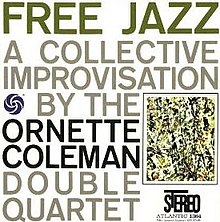Free Jazz: A Collective Improvisation
| Free Jazz: A Collective Improvisation | ||||
|---|---|---|---|---|
 |
||||
| Studio album by Ornette Coleman | ||||
| Released | September 1961 | |||
| Recorded | December 21, 1960 | |||
| Genre |
Free jazz Avant-garde jazz |
|||
| Length | 37:10 | |||
| Label | Atlantic SD 1364 | |||
| Producer | Nesuhi Ertegün | |||
| Ornette Coleman chronology | ||||
|
||||
| Professional ratings | |
|---|---|
| Review scores | |
| Source | Rating |
| Down Beat | |
| Allmusic | |
| The Penguin Guide to Jazz | |
| Yahoo! Music | (favorable) |
| The Rolling Stone Jazz Record Guide | |
Free Jazz: A Collective Improvisation is the sixth album by jazz saxophonist and composer Ornette Coleman, released on Atlantic Records in 1961, his fourth for the label. Its title established the name of the then-nascent free jazz movement. The recording session took place on December 21, 1960, at A&R Studios in New York City. The sole outtake from the album session, "First Take," was later released on the 1971 compilation Twins.
The album features a double quartet, one in each stereo channel. The personnel consists of Coleman's touring quartet (horns on one side, rhythm on the other), augmented by returning Coleman Quartet drummer Billy Higgins, multi-instrumentalist Eric Dolphy, and trumpeter Freddie Hubbard. Bassist Scott LaFaro, whom Coleman had worked with the previous two days on sessions for Gunther Schuller, would both appear on this album and replace bassist Charlie Haden in the Quartet for Coleman's next album, Ornette!.
The rhythm sections play simultaneously, and though there is a succession of solos as is usual in jazz, they are peppered with freeform commentaries by the other horns that often turn into full-scale collective improvisation. The pre-composed material is a series of brief, dissonant fanfares for the horns which serve as interludes between solos. Not least among the album's achievements was that it was the first album-length improvisation, nearly forty minutes, which was unheard of at the time.
The original LP package incorporated Jackson Pollock's 1954 painting The White Light. The cover was a gatefold with a cutout window in the lower left corner, allowing a glimpse of the painting; opening the cover revealed the full artwork, along with liner notes by critic Martin Williams.
...
Wikipedia
